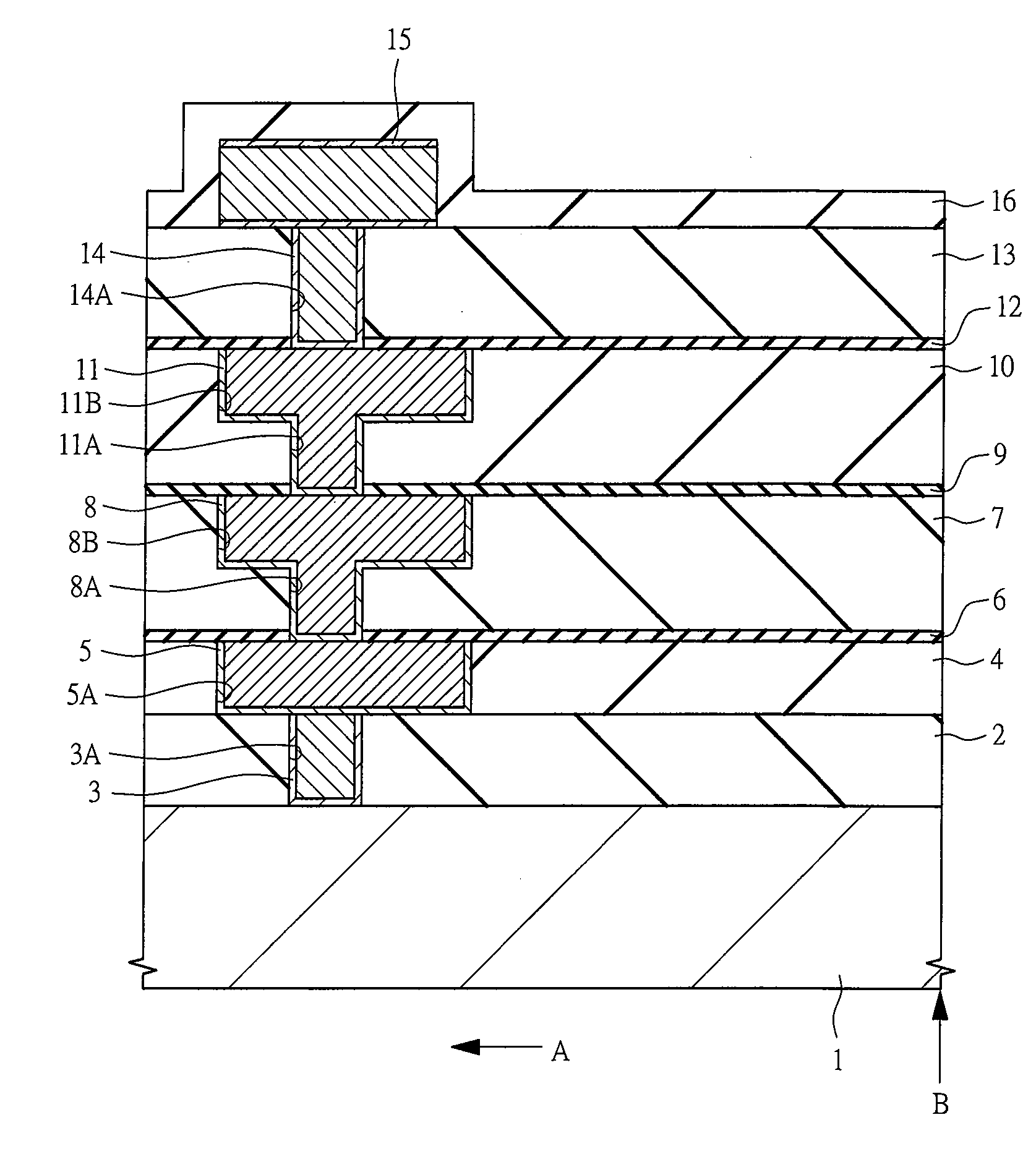Semiconductor device
a technology of semiconductor devices and insulators, applied in semiconductor devices, semiconductor/solid-state device details, electrical equipment, etc., can solve the problems of affecting the efficiency of etching, affecting the peeling of interlayer insulators, and increasing the depth of trench processes for etching
- Summary
- Abstract
- Description
- Claims
- Application Information
AI Technical Summary
Benefits of technology
Problems solved by technology
Method used
Image
Examples
first embodiment
[0065]Hereinafter, the first embodiment will be described in detail with reference to FIG. 4 to FIG. 14.
[0066]FIG. 4 is a cross section diagram of a principal part in a vicinity of an edge portion of a semiconductor device (chip) according to the first embodiment. In FIG. 4, an arrow A indicates an inward direction of the semiconductor device, and an arrow B indicates an edge portion of the semiconductor device. A circuit formation region where a semiconductor element, a wire and the like are formed is defined by the side of the arrow A.
[0067]In the semiconductor device according to the first embodiment, for example, interlayer insulators (first insulator) 2 and 4 are formed on a main surface of the semiconductor substrate 1 made of single crystal silicon or the like, and the via 3 and the buried wire (first wire) 5 are formed in these interlayer insulators 2 and 4. The interlayer insulators 2 and 4 are formed from, for example, a BPSG (Boron-doped Phospho Silicate Glass) film, a SO...
second embodiment
[0090]Next, a second embodiment will be described in detail with reference to the drawings. FIG. 15 is a cross section diagram of a principal part in a vicinity of an edge portion of a semiconductor device (chip) according to the second embodiment.
[0091]The difference between the first embodiment and the second embodiment lies in that not only the cap insulator 6 but also the cap insulator 9 is not provided in the edge portion of the semiconductor device.
[0092]Hereinafter, an operational effect of the semiconductor device according to the second embodiment will be described.
[0093]In the case where the interlayer insulator made of a Low-k film having relatively low Young's modulus and the cap insulator having relatively high Young's modulus are stacked in combination, the stress at the closest interface to the semiconductor substrate 1 is largest. However, depending on a form, a structure, and a material to package the semiconductor device or a use environment of the package, the str...
third embodiment
[0095]Next, the third embodiment will be described in detail with reference to FIG. 16. FIG. 16 is a planar layout diagram for describing the non-providing portion 31 of the cap insulator 6 (cf. FIG. 4 as well) in a semiconductor device according to the third embodiment.
[0096]The difference between the third embodiment and the first embodiment lies in that the non-providing portion 31 of the cap insulator 6 is formed only in the vicinity of the chip corners of the semiconductor device 21. The non-providing portion 31 according to the third embodiment has a width of at least about 1 μm or more from the chip corner toward the in-plane center direction, and more preferably has a width of about 5 μm or more.
[0097]Hereinafter, an operational effect of the semiconductor device according to the third embodiment will be described.
[0098]As described in the first embodiment, the stress generated in the thermal cycle test in the assembly process after sealing the semiconductor device 21 with r...
PUM
 Login to View More
Login to View More Abstract
Description
Claims
Application Information
 Login to View More
Login to View More - R&D
- Intellectual Property
- Life Sciences
- Materials
- Tech Scout
- Unparalleled Data Quality
- Higher Quality Content
- 60% Fewer Hallucinations
Browse by: Latest US Patents, China's latest patents, Technical Efficacy Thesaurus, Application Domain, Technology Topic, Popular Technical Reports.
© 2025 PatSnap. All rights reserved.Legal|Privacy policy|Modern Slavery Act Transparency Statement|Sitemap|About US| Contact US: help@patsnap.com



